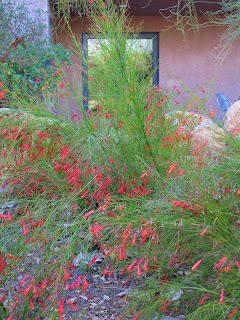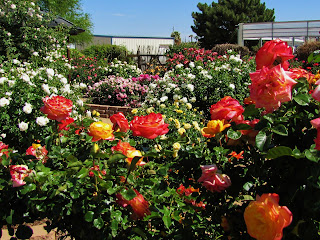The Ironwood is one of the largest and longest-lived Sonoran Desert plants, reaching 45 feet in height and persisting as long as 1,500 years. During these hot days of summer, I wanted to share this very native tree to homeowners. Recently at the Gardens, people have asked me about the Mexican Buckeye and Ironwood. The high school I work at is called Ironwood Ridge and is surrounded by many of these slow growing trees. Owls love to call the Ironwood their home as do many other birds. I found this article that I thought I'd share with you from the Pima County State Files. In the spring, these trees have a lovely lavender to dark purple blossom. The bark is a solid silver grey color. It is more commonly seen around washes and in the Oro Valley area, but they do grow in town. Most people in the city of Tucson don't use this plant in their landscape because it's slow growing. It is a highly recommended tree however for our residents both local and wild:) The article is as follows....
 |
| Don't worry...you can train this as a tree and it gets about 20 to 25 feet high and around 30 feet wide. Some places report this tree as high as 45 feet. The trees around school are pruned yearly. |
"It is a single or multi-trunked evergreen tree, and displays lavender to pink flowers in May. By early summer, the pods mature. Each 2-inch pod contains one to four shiny brown seeds that are relished by many Sonoran animals, from small mammals and birds to humans. Its iron-like wood is renowned as one of the world's densest woods.
The shaded sanctuary and richer soils created by ironwoods increase plant diversity and provide benefits to wildlife. Ironwoods are too hard to provide nesting cavities for birds, but the cacti that grow beneath them provide such opportunities. Insects abound within the ironwood complex, attracting birds and reptiles. As with other legumes, the ironwood's leaf litter supplies nitrogen to the soil and its seeds provide a protein-rich resource for doves, quail, coyotes, and many small rodents.
The Ironwood tree is found only in the Sonoran Desert, in the dry locales below 2,500 feet, where freezing temperatures are uncommon. In fact the Ironwood's habitat is almost an exact match of the Sonoran Desert boundry. Ironwoods are most common in dry ephemeral washes. Ironwoods function as oases of fertile and sheltered habitat within a harsh and challenging desert landscape. As a tree becomes established, it tempers the physical environment beneath it, creating a micro-habitat with less direct sunlight, lower surface temperatures, more organic matter, higher water availability, and protection from herbivores. Because of these factors, the Ironwood tree has immense ecological value in the Sonoran Desert.
Ironwood grows taller than most trees in Sonoran desert scrub, so it serves as a great perch and roost for hawks and owls. It's dense canopy is utilized by nearly 150 bird species. Add tall ironwoods to the scrubby vegetation on some desert bajadas, and you're likely to add 63 percent more birds than creosote, cactus and bursage alone could support. The ironwood's canopies are so dense that they reduce the probability of extreme heat exposure in the summer.
Air temperatures may be 15 degrees cooler under ironwoods than in the open desert sun five feet away. Ironwood also shelters frost sensitive young saguaros, organ pipe cactus, night-blooming cereus and many other native plants growing beneath them. More than 230 plant species have been recorded starting their growth within the protective microclimate under ironwood "nurse plants." This also creates an optimum wildflower nursery which is foraged by rabbits, bighorn, and other native species.
In addition to the birds, there are 62 reptiles and amphibians, and 64 mammals that use ironwoods for forage, cover and birthing grounds. At just one site in the Silverbell Mountains, an ironwood-bursage habitat also shelters some 188 kinds of bees, 25 ant colonies, and 25 other types of insects. That adds up to an extraordinary level of biodiversity." End of article. So there you have it....another lovely native tree to put into your Sonoran yard:) Currently they are rebounding from our severed winter freeze. Some need to be pruned up. The owls love the Ironwood! We had several owlings last summer around July. I wish I had brought my camera, but I'll remember next time. Source:
http://www.pima.gov/cmo/sdcp/species/iw/illus.html





















































